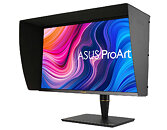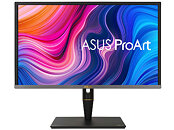Thursday, April 23rd 2020

ASUS Announces ProArt Display PA32UCX-P and PA27UCX
ASUS today announced ProArt Display PA32UCX-P and PA27UCX, 4K HDR monitors for professional content creators with groundbreaking Off-Axis Contrast Optimization (OCO) technology that maintains color accuracy in wide-angle viewing and makes the monitors ideal collaboration tools. The 32-inch PA32UCX-P and 27-inch PA27UCX feature mini-LED backlighting and support for multiple HDR formats, including Dolby Vision, HDR10 and Hybrid Log Gamma (HLG). PA32UCX-P offers a peak brightness of 1200 cd/m² with 1152 zones of local dimming control, and PA27UCX offers a peak brightness of 1000 cd/m² with 576 zones.
Designed to give content creators professional-grade color performance, PA32UCX-P and PA27UCX come pre-calibrated and provide a Delta-E (ΔE) color accuracy of less than one in the sRGB and Adobe RGB color spaces. They also feature quantum-dot technology that supports the DCI-P3, Rec. 709, Rec. 2020, sRGB and Adobe RGB color spaces. For seamless calibration, the monitors are compatible with most major calibrators and professional calibration software.Pioneering mini-LED displays with wide-view color accuracy
ProArt Display PA32UCX-P and PA27UCX feature excellent color and contrast with a wide viewing angle. Most mini-LED monitors have color accuracy issues when viewed from a wide angle, which presents a problem when collaborating with clients or colleagues on color-critical work. The groundbreaking Off-Axis Contrast Optimization (OCO) technology in PA32UCX-P and PA27UCX solves this problem with a compensation layer that controls light transmittance. OCO technology reduces the halo effect by 80% and provides a 7X contrast-ratio enhancement for dark colors when viewing the screen from a wide angle. Through OCO technology, the monitors ensure that on-screen content is displayed accurately to all viewers.
4K displays with Dolby Vision, HDR10 and Hybrid Log Gamma support
ProArt Display PA32UCX-P and PA27UCX feature ASUS Smart HDR technology, which supports multiple High Dynamic Range (HDR) formats and multiple PQ curves to suit needs specific to content creators. PA32UCX-P and PA27UCX both support Dolby Vision HDR, delivering ultravivid quality, incredible brightness, contrast, color and detail to transform entertainment experiences and make storytelling come alive. Dolby Vision achieves astonishing image quality through cinema-inspired HDR technology that can deliver billions of colors. When compared to a standard picture, Dolby Vision ensures a brilliant picture with a full range of tones, including highlights that are up to 40X brighter and blacks that are 10X darker.
ProArt Display PA32UCX-P and PA27UCX support HDR10 and multiple PQ curves - including PQ Hard Clip, PQ Optimized and PQ Basic - to meet content creators' needs and ensure compatibility with existing streaming video services and a growing list of HDR-enabled games. HDR10 is also supported by the HDR Preview function, which enables video creators to connect their camera directly to ProArt PA32UCX-P and PA27UCX and view captured HDR content with its full tonal range. HDR Preview also automatically works in video editing software, enabling creators to view accurate simulations of final output for an easier and more streamlined editing experience.
Support for Hybrid Log Gamma (HLG) enables use with broadcast and satellite TV, including with the BBC iPlayer, Japan NHK TV and DirecTV. The HDR Preview function also supports HLG formats.
Industry-leading color performance
ProArt Display PA32UCX-P offers true 10-bit color depth with a 1200 cd/m² peak brightness, and PA27UCX offers a 1000 cd/m² peak brightness, providing an entire spectrum of colors to work with for video editing and post-production. Quantum-dot technology supports the cinema-standard DCI-P3 color gamut, resulting in more realistic colors. PA32UCX-P delivers a wide color gamut of 99% DCI-P3, 99.5% Adobe RGB, 89% Rec. 2020, 100% sRGB and Rec. 709, and PA27UCX provides 97% DCI-P3, 99.5% Adobe RGB, 83% Rec. 2020, 100% sRGB and Rec. 709. With professional-grade color performance, both monitors are suited for high-end video editing and post-production.
ProArt Display PA32UCX-P and PA27UCX are pre-calibrated to guarantee an industry-leading Delta-E color accuracy of less than one in the sRGB and Adobe RGB color spaces. The monitors feature advanced grayscale technology to ensure images are accurately reproduced on screen. PA32UCX-P and PA27UCX also include technology to ensure 95% uniformity compensation to guard against brightness and chroma (color) fluctuations across different parts of the screen.
Broad compatibility for comprehensive calibration
ProArt Display PA32UCX-P and PA27UCX include ASUS ProArt software that supports top calibrators from X‑Rite, Datacolor, Klein professional calibration software, such as Calman and Light Illusion ColourSpace CMS. Users also can choose from a variety of advanced settings to achieve optimum color accuracy, and can save color parameter settings on the monitor's integrated circuit (IC) chip to enable accurate, consistent color across various connected devices.
Designed to give content creators professional-grade color performance, PA32UCX-P and PA27UCX come pre-calibrated and provide a Delta-E (ΔE) color accuracy of less than one in the sRGB and Adobe RGB color spaces. They also feature quantum-dot technology that supports the DCI-P3, Rec. 709, Rec. 2020, sRGB and Adobe RGB color spaces. For seamless calibration, the monitors are compatible with most major calibrators and professional calibration software.Pioneering mini-LED displays with wide-view color accuracy
ProArt Display PA32UCX-P and PA27UCX feature excellent color and contrast with a wide viewing angle. Most mini-LED monitors have color accuracy issues when viewed from a wide angle, which presents a problem when collaborating with clients or colleagues on color-critical work. The groundbreaking Off-Axis Contrast Optimization (OCO) technology in PA32UCX-P and PA27UCX solves this problem with a compensation layer that controls light transmittance. OCO technology reduces the halo effect by 80% and provides a 7X contrast-ratio enhancement for dark colors when viewing the screen from a wide angle. Through OCO technology, the monitors ensure that on-screen content is displayed accurately to all viewers.
4K displays with Dolby Vision, HDR10 and Hybrid Log Gamma support
ProArt Display PA32UCX-P and PA27UCX feature ASUS Smart HDR technology, which supports multiple High Dynamic Range (HDR) formats and multiple PQ curves to suit needs specific to content creators. PA32UCX-P and PA27UCX both support Dolby Vision HDR, delivering ultravivid quality, incredible brightness, contrast, color and detail to transform entertainment experiences and make storytelling come alive. Dolby Vision achieves astonishing image quality through cinema-inspired HDR technology that can deliver billions of colors. When compared to a standard picture, Dolby Vision ensures a brilliant picture with a full range of tones, including highlights that are up to 40X brighter and blacks that are 10X darker.
ProArt Display PA32UCX-P and PA27UCX support HDR10 and multiple PQ curves - including PQ Hard Clip, PQ Optimized and PQ Basic - to meet content creators' needs and ensure compatibility with existing streaming video services and a growing list of HDR-enabled games. HDR10 is also supported by the HDR Preview function, which enables video creators to connect their camera directly to ProArt PA32UCX-P and PA27UCX and view captured HDR content with its full tonal range. HDR Preview also automatically works in video editing software, enabling creators to view accurate simulations of final output for an easier and more streamlined editing experience.
Support for Hybrid Log Gamma (HLG) enables use with broadcast and satellite TV, including with the BBC iPlayer, Japan NHK TV and DirecTV. The HDR Preview function also supports HLG formats.
Industry-leading color performance
ProArt Display PA32UCX-P offers true 10-bit color depth with a 1200 cd/m² peak brightness, and PA27UCX offers a 1000 cd/m² peak brightness, providing an entire spectrum of colors to work with for video editing and post-production. Quantum-dot technology supports the cinema-standard DCI-P3 color gamut, resulting in more realistic colors. PA32UCX-P delivers a wide color gamut of 99% DCI-P3, 99.5% Adobe RGB, 89% Rec. 2020, 100% sRGB and Rec. 709, and PA27UCX provides 97% DCI-P3, 99.5% Adobe RGB, 83% Rec. 2020, 100% sRGB and Rec. 709. With professional-grade color performance, both monitors are suited for high-end video editing and post-production.
ProArt Display PA32UCX-P and PA27UCX are pre-calibrated to guarantee an industry-leading Delta-E color accuracy of less than one in the sRGB and Adobe RGB color spaces. The monitors feature advanced grayscale technology to ensure images are accurately reproduced on screen. PA32UCX-P and PA27UCX also include technology to ensure 95% uniformity compensation to guard against brightness and chroma (color) fluctuations across different parts of the screen.
Broad compatibility for comprehensive calibration
ProArt Display PA32UCX-P and PA27UCX include ASUS ProArt software that supports top calibrators from X‑Rite, Datacolor, Klein professional calibration software, such as Calman and Light Illusion ColourSpace CMS. Users also can choose from a variety of advanced settings to achieve optimum color accuracy, and can save color parameter settings on the monitor's integrated circuit (IC) chip to enable accurate, consistent color across various connected devices.




12 Comments on ASUS Announces ProArt Display PA32UCX-P and PA27UCX
Nitpicking here, but Rec 907 is the same thing as sRGB from a customer's point of view, I'm not sure they need to be listed separately.
IPS vs TN always was IPS = Better Colour and TN = Faster Pixel response.
Now ofcourse over the years both sides improved themselves so they are closer now but still excell in their own rights.
So when you say "good enough" I mean sure, depending on your standards, but many people say they still prefere IPS for the accuracy.
So im thinking maybe you can combine a TN panel with Quantum Dot layer to improve it on the colour front so even IPS people would consider it.
And what do you mean by "jumps all over the place", I know TN has bad viewing angles but do you mean to say that merely looking left or right while sitting infront of the monitor already messes things up? Because I dont expect anyone would ever buy a TN panel if that were the case.
The viewing angles have improved over time, TN's signature is still its quick darkening when viewed from a certain angle (usually from below).
The current model is already over three grand.
www.amazon.com/PA32UCX-Professional-Thunderbolt-DisplayPort-Displayhdr1000/dp/B07XTYZQM2